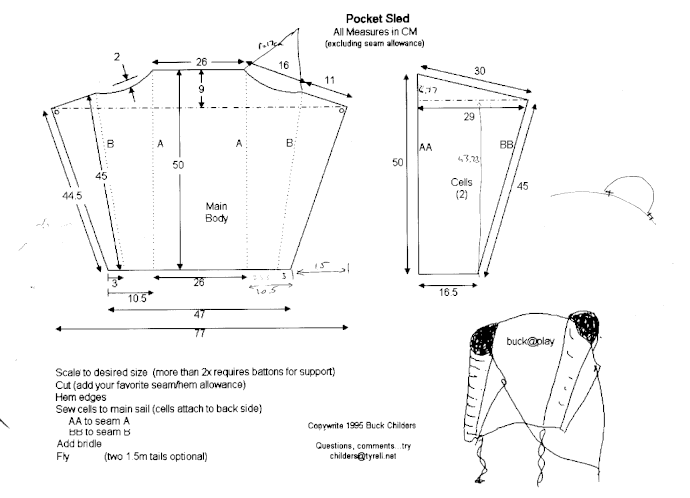Scaling
The experience of most framed kite makers is that kites don’t scale. A design that flies well with a 1m wingspan, will not fly well, or at all, if scaled down to 100mm or up to 10m. But this is because the weight /area ratio of framed kites increases with size, and changes in weight/area profoundly affect stability. Larger framed kites also flex, bend and distort proportionally a lot more than small ones, which effects flying behaviour. Above about 10m wingspan, even with carbon fibre, framed kites become either too heavy to fly in a useful wind range, or very fragile.
My experience is that single line kites do generally scale and over a very wide range- provided their weight/area ratio stays relatively constant.
The smallest ram air flag kite is 0.75 m span, 0.35sq.m, 0.1kg. The largest is 45m span, 1250 sq.m, 360kg. The mini’s weight/area is around 0.28kg/sq.m, the mega’s is 0.29kg/sq.m. They both fly well, and very similarly, with good recovery and no weaving. The mega is more than 3,500 x’s the mini by area.
Single skin kites can also be scaled up until fabric and corded reinforcements reach their strength limit without any significant increases in weight/area- but in very large sizes would have far too much pull to be practical for kite event flying.
Apart from weight/area, there are some other properties of kites that don’t scale:
As referred to above, there is a non-scaling effect in deflections- that fabric and structures are subject to higher overall loads in larger kites, so will deflect/distort/bend proportionally more. This is significant for rigid and framed kites. but isn’t generally noticeable for ram air or single skin kites within fabric and cording strength limits.
For ram air kites, the mass of enclosed air increases with the cube of dimension while their area and weight scale with the square. Air doesn’t have weight, but it has mass. To mitigate this, in very large sizes, ram air kites are made with no internal partitions so that their enclosed air mass ( > 5 tonnes for a 1250 sq.m flag kite) can rotate somewhat independently when the kite is correcting - otherwise its inertia would slow correction to a problematical extent.
Reynolds number (Re) effects. Re is an indicator of the onset of turbulent flow, which definitely doesn’t scale- but is also only significant for very tiny kites in our case.
Surface roughness doesn’t scale (a 20mm bump is significant for a small kite but less relevant on a larger one) - and has some effect I expect- has been posited as the reason that very large leading-edge inflatable (LEI) kite surfing kites fly in lighter winds than smaller ones.
And entrained air mass? When a kite moves it carries some mass of air with it (not just the boundary layer) and this mass is a cube function of dimension, not square - how significant is this for scaling?
This review is encouraging about perhaps almost no limit for scaling for a (flexible) single skin kite which does not undergo the mass of enclosed air in inflatable cells of a ram air kite. The limits are the resistance of material.
